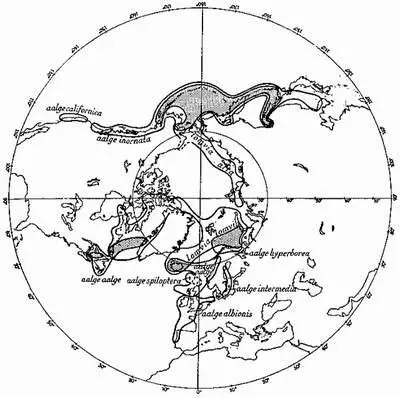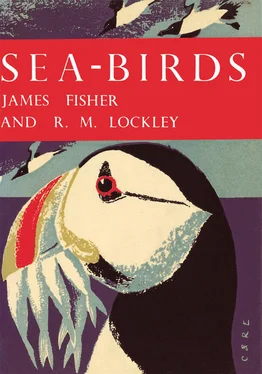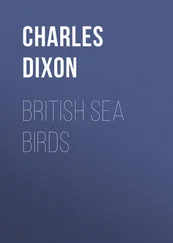Various suggestions could be made as to the origins of the two guillemots, the common and Brünnich’s guillemot ( Fig. 8). Possibly the original guillemot was a common guillemot ( Uria aalge ) type which got divided into two subspecies in the Atlantic and Pacific by the Ice Age, but not before it had had time to give rise to an arctic race adapted to the harder life. After the Ice Age, with the ameliorating conditions, perhaps both the Atlantic and the Pacific guillemots began pushing north again, this time to meet and overlap with their arctic descendant, which, meantime, had differentiated sufficiently to offer no direct competition. It is interesting to note that the most arctic of the common guillemot races, Uria aalge hyperborea of Iceland, Novaya Zemlya, and Lapland, has a very thick bill and a considerable resemblance to Brünnich’s guillemot, with which it, however, does not interbreed, nor apparently compete. Perhaps it is recapitulating some of the early stages in the origin of Brünnich’s guillemot. To some extent Brünnich’s guillemot, with its razorbill-like beak, appears to replace the razorbill in the arctic, where it may occupy the same ecological (feeding and breeding) niche in relation to the common guillemot as the razorbill does in relation to that bird in the south part of the common guillemot’s range.
The student of variation will find much material for his researches among the North Atlantic sea-birds. Several species of North Atlantic birds, notably the common guillemot, the three smaller skuas and the fulmar, are polymorphic or dimorphic. They exist in several so-called phases. Some common guillemots have a white ring embracing their eye from which a white line runs back towards the back of their heads. These are called ‘bridled’ guillemots, and were for long actually thought to be of a different species. The phases of the skuas range from very light phases with yellow over their ears and the back of their necks, white throats and bellies, to those which are almost uniformly brown. The breeding fulmar population of Britain, the Faeroes, Iceland, Jan Mayen and West Greenland are all light-coloured with white bellies, necks and breasts, but in Baffin Island, Spitsbergen and Franz Josef Land the fulmars are nearly all very dark coloured. Between the light forms of Britain, etc., and the dark forms of Spitsbergen, there are a number of puzzling intermediates, most in evidence on Bear Island (and often to be seen at sea in the Rockall area), and the situation among the fulmars is therefore one not of dimorphism but of polymorphism, as it is among the skuas.
FIG. 6
Breeding distribution of a group of closely-related gulls: Larus occidentalis , the western gull: L. glaucescens , the glaucous-winged gull; L. schistisagus , the slaty-backed gull; L. hyperboreus , the glaucous gull; and L. marinus , the great black-back. Areas of overlap shaded. Black areas in Canadian Arctic represent outpost breeding-places of L. marinus
Southern, who has carefully studied the problem of the differential distribution of the bridled guillemot, thinks that its ‘bridle’ is probably controlled by a single Mendelian factor, which appears to control also a slight difference in the skull structure and the shape of the tail-feathers. He organised counts of the percentage of bridled guillemots throughout Britain in the years round 1939 and again in those round 1949; and he has also collected as much evidence as he could from the rest of the guillemot’s range. Two main conclusions are apparent: first, the percentage of bridled birds increases from SSE to NNW (with a reversal in Iceland); and secondly the percentage is not always constant at any one place—there are signs of trends towards increase or decrease, and of shifts, or drifts, of the balance. Possibly the possession of a bridle gives a guillemot an advantage over other guillemots in some environments, and a disadvantage in others, though we do not know why: the alternative is that possession of the bridle is the result of an advantageous mutation that is spreading through the population; which is unlikely to be the case on the evidence, though Southern has been careful to show that the possibility still exists. There is no indication that bridled guillemots prefer to mate with each other rather than with unbridled guillemots; mating in a mixed colony appears to be completely, or almost completely, at random.
FIG. 7
Breeding distribution of three closely-related terns: Sterna hirundo , the common tern; S. paradisaea , the arctic tern; S. forsteri , Forster’s tern. Areas of overlap shaded. S. h. turkestanica is a doubtful subspecies
Southern shows that the percentage of bridled birds marches fairly closely with humidity and cloudiness; but, as he points out, many other factors may be involved. The changes between c .1939 and c .1949 may be linked with the climatic amelioration, but “might very well be due to random fluctuation.” The actual percentages as recorded in the paper of Southern and Reeve (1941) and Southern (1951), and in a few notes published by other observers, are shown on the maps (Figs. 9a, 9b). The results of Southern’s enquiry of 1949 have shown that out of the very many colonies studied in Britain at only five has a significant * change been recorded in ten years, four of which show decreases of the percentage of bridled birds and one an increase. One of the decreases is at St. Kilda, where the expedition of 1939 found 16.5 per cent. of the guillemots bridled and that of 1948 only 10.3 per cent. (one of us took part in both counts). Other decreases in Britain have been significant, as at the Isle of May, 5.3 to 3.2 in ten years; and at Unst in Shetland—23.8 to 16.9 per cent. in the same period. There has also been a significant decrease—of about one-third—in Iceland; thus at Grimsey in the north, from 8.7 in 1939 to 6.9 per cent. in 1949; at Hafnaberg, in south-west Iceland, from 29 per cent. in 1939 to 18.1 per cent. in 1949; in the Westmann Islands a parallel decline from 75 per cent. in 1935 (Lockley, 1936) to 50 per cent. in 1949.

FIG. 8
Breeding distribution of two closely-related guillemots or murres: Uria aalge , the common guillemot; and U. lomvia , the arctic guillemot (Brünnich’s guillemot * in the Atlantic, Pallas’s murre in the Pacific). Areas of overlap shaded.
Increases noted in the 1939–1949 enquiries were several, but only one, at Foula in Shetland, was significant and by checked observers (from 24 per cent. in 1938 to 29.4 per cent. in 1948–49). Increases on the margin of significance were recorded from St. Bee’s Head in Cumberland, Marwick Head in Orkney, and the Fair Isle. Apart from these small increases in the last decade, there was a significant increase of the percentage on Noss in Shetland from 15.5 in 1890 to 26.5 in 1938, which seems great enough to embrace a possible slight observer-error.
Unfortunately, too few of the early bridled guillemot counts are reliable, though some from Berneray and Mingulay (‘Barra Head’) in the Outer Hebrides may be so. This had 20.2 per cent. in 1871; 12 in 1939; 9.8 in 1949; 12.6 in 1950. The decrease between 1871 and 1939 is significant, though the other apparent changes are not so. Elsewhere we have followed Southern in discarding such vague records as ‘about one in every nine or ten.’
Nothing is yet known about the percentage of bridled guillemots along the coast of Norway, except that it has remained slightly over 50 per cent., at Bear Island from 1932 to 1948. At the Karlov Islands off the Murmansk coast the percentage was 42 in 1938. It seems likely, from the rather scanty figures from Novaya Zemlya, which Southern slightly misdates and misplaces, that the percentage may be about the same on islets in Pukhovy and Bezymiannaya Bays off that island (36.4 and 50).
Читать дальше













